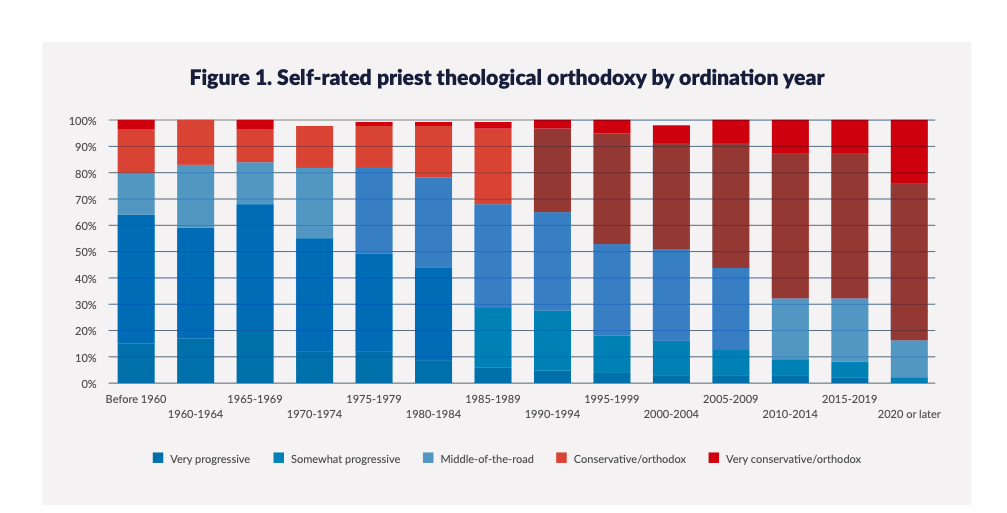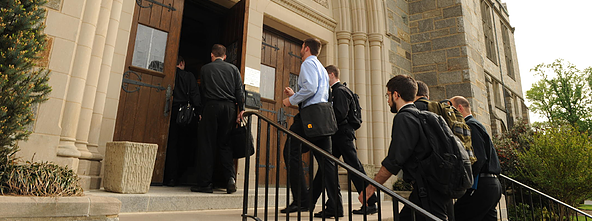Are young priests more orthodox than previous generations? The good news is the answer is “yes,” as proven in the below study. But this means only one of two things: Either younger priests are truly more conservative than older priests –or– the diocesan priesthood in America liberalizes many or most.
The above is a picture of the Theological College, the Catholic seminary producing priests across the street from Catholic University of America (CUA) in Washington DC. One of the research groups at CUA is called The Catholic Project which recently published a study on how American Catholic priests self-identify as either orthodox or progressive. The title of the study is called “Polarization, Generational Dynamics, and the Ongoing Impact of the Abuse Crisis: Further Insights from the National Study of Catholic Priests” and it’s found here. Here’s one graph from the study:

Most conservative commentators online have been celebrating this as “a win.” I also want to see it as “a win.” But the problem is that the above graph reveals a pattern that has been going on since the days of John Paul II: Young guys start orthodox, but move to become more unorthodox in the priesthood.
Remember: The priests ordained in 1985 were once as conservative as the guys ordained in 2015. The priests ordained in 1997 were once as conservative as guys ordained in 2017. The problem is every generation of priest is pressured to get more progressive by his pastor and bishop. Of course, it’s not framed this way. Rather, the pressure is slow: “Hey, we need you to grow in priestly fraternity with the older priests.” Or, “Look, Michael, I was as zealous as you when I was first ordained. But then I learned how to grow in pastoral charity once I became a pastor.”
That is why the 2015-2019 guys sound more conservative than the 1990-1994 guys. But keep in mind the obvious: The 1990-1994 guys are not baby-boomers. There were ordained under John Paul II who is still seen as conservative by most, at least compared to the current regime. Not all, but most those guys crack under baby-boomer pressure. Or, if you don’t believe me and you prefer to get excited about the above CUA study, just go ask any old conservative priest in your diocese if his friends from seminary got more liberal or more conservative. By “conservative,” I don’t just mean they give “a pro-life sermon” once a year. I mean they teach Jesus is the only way to the Father. I mean they preach against contraception to the enormous population of married-Catholics still on the Pill in their pews on Sundays.
At one point they had the intention of preaching these things. But five years into their priesthood, it stops. Why? It’s a slow burn into modernism, and especially into the heresy of indifferentism (the ubiquitous heresy that all religions will get you to heaven.)
Notice, again, I do not doubt the above CUA study or graph. I agree young priests are more conservative. But this has been the repeat pattern since the 1980s. This means one thing: Diocesan ecumenism and the new sacraments can’t help but move young men into modernism bit-by-bit. That’s how I explain the above increase in red in the chart going left-to-right. I also saw it with the guys I went to seminary with: Believe it or not, I was one of the least traditional seminarians in my regular diocesan seminary class beginning in 2004.
In May 2021 I wrote an article on if young traditionalists should fake being less pious in seminary in order to just get ordained and game the system. I answered “no.” One of the reasons I said no was because most the orthodox seminarians coming out will eventually crack on their conscience or get sent to the funny-farm or get exiled to a backwater parish (and possibly laicized.) In that article, I wrote: “I suspect 80% of the conservatives ordained for normal dioceses compromise their conscience on doctrine or liturgy within the first three years.” Of course, the guys who don’t break down might very well get sacked like Bishop Strickland this weekend (about whom I made this video.)
So, don’t get too excited about the above CUA graph. We’ve been excited for those patterns since the days of JPII. And yet, paradoxically, the American clergy as-a-whole keeps getting more liberal through the years after Vatican II. How can that be? It’s simple: The ecumenism hasn’t “set-in” yet.
You might be thinking, “This is just Fr. Nix speaking from his wounds of not being well-accepted in his diocese.” Or, you might be thinking, “This is purely anecdotal evidence from the priests he has met in his life.” I admit this blog is only my anecdotal evidence on top of a pretty solid self-identification study of American priests as done by CUA above.
But here’s my suggestion so you can try to confirm or deny my anecdotal evidence: Go find one of the good old baby-boomer conservative diocesan priests in your diocese who somehow stayed a priest without getting washed out or going lefty. Go ask him if from seminary onwards he just maintained the true faith around liberal seminarians (those liberal from-the-start) or if he held the line when others did not. Probably a 70% chance he will answer as Archbishop Lefebvre once said: I did not change—they did.
So, what is the solution? The temporary and local solution is for young men to enter only traditional congregations. But the long-term and global solution is that the Catholic Church as a whole (from the top down) must renounce every form of modernism in doctrine and liturgy. Yep, I get tired of writing it, but that’s the only answer: A full return to Apostolic Catholicism, the old sacraments and preaching Jesus Christ crucified to the entire world.
